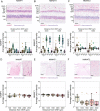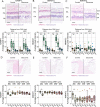NAD salvage pathway machinery expression in normal and glaucomatous retina and optic nerve
- PMID: 36681854
- PMCID: PMC9867855
- DOI: 10.1186/s40478-023-01513-0
NAD salvage pathway machinery expression in normal and glaucomatous retina and optic nerve
Abstract
Glaucoma is the leading cause of irreversible blindness and is a major health and economic burden. Current treatments do not address the neurodegenerative component of glaucoma. In animal models of glaucoma, the capacity to maintain retinal nicotinamide adenine dinucleotide (NAD) pools declines early during disease pathogenesis. Treatment with nicotinamide, an NAD precursor through the NAD salvage pathway, robustly protects against neurodegeneration in a number of glaucoma models and improves vision in existing glaucoma patients. However, it remains unknown in humans what retinal cell types are able to process nicotinamide to NAD and how these are affected in glaucoma. To address this, we utilized publicly available RNA-sequencing data (bulk, single cell, and single nucleus) and antibody labelling in highly preserved enucleated human eyes to identify expression of NAD synthesizing enzyme machinery. This identifies that the neural retina favors expression of the NAD salvage pathway, and that retinal ganglion cells are particularly enriched for these enzymes. NMNAT2, a key terminal enzyme in the salvage pathway, is predominantly expressed in retinal ganglion cell relevant layers of the retina and declines in glaucoma. These findings suggest that human retinal ganglion cells can directly utilize nicotinamide and could maintain a capacity to do so in glaucoma, showing promise for ongoing clinical trials.
Keywords: Axon degeneration; Glaucoma; Metabolism; NAD; Neurodegeneration; Nicotinamide; Optic nerve; Retinal ganglion cell.
© 2023. The Author(s).
Conflict of interest statement
PAW is an inventor on an awarded US patent held by The Jackson Laboratory for nicotinamide treatment in glaucoma (“Treatment and prevention of ocular neurodegenerative disorder”, US11389439B2). All other authors declare that they have no competing interests.
Figures




Similar articles
-
Oral nicotinamide provides robust, dose-dependent structural and metabolic neuroprotection of retinal ganglion cells in experimental glaucoma.Acta Neuropathol Commun. 2024 Aug 23;12(1):137. doi: 10.1186/s40478-024-01850-8. Acta Neuropathol Commun. 2024. PMID: 39180087 Free PMC article.
-
Nicotinamide and WLDS Act Together to Prevent Neurodegeneration in Glaucoma.Front Neurosci. 2017 Apr 25;11:232. doi: 10.3389/fnins.2017.00232. eCollection 2017. Front Neurosci. 2017. PMID: 28487632 Free PMC article.
-
Nicotinamide provides neuroprotection in glaucoma by protecting against mitochondrial and metabolic dysfunction.Redox Biol. 2021 Jul;43:101988. doi: 10.1016/j.redox.2021.101988. Epub 2021 Apr 24. Redox Biol. 2021. PMID: 33932867 Free PMC article.
-
The Role of NAD+ and Nicotinamide (Vitamin B3) in Glaucoma: A Literature Review.J Nutr Sci Vitaminol (Tokyo). 2022;68(3):151-154. doi: 10.3177/jnsv.68.151. J Nutr Sci Vitaminol (Tokyo). 2022. PMID: 35768245 Review.
-
Glaucoma as a Metabolic Optic Neuropathy: Making the Case for Nicotinamide Treatment in Glaucoma.J Glaucoma. 2017 Dec;26(12):1161-1168. doi: 10.1097/IJG.0000000000000767. J Glaucoma. 2017. PMID: 28858158 Free PMC article. Review.
Cited by
-
Nicotinamide Prevents Retinal Vascular Dropout in a Rat Model of Ocular Hypertension and Supports Ocular Blood Supply in Glaucoma Patients.Invest Ophthalmol Vis Sci. 2023 Nov 1;64(14):34. doi: 10.1167/iovs.64.14.34. Invest Ophthalmol Vis Sci. 2023. PMID: 38010699 Free PMC article.
-
The role of RGC degeneration in the pathogenesis of glaucoma.Int J Biol Sci. 2025 Jan 1;21(1):211-232. doi: 10.7150/ijbs.103222. eCollection 2025. Int J Biol Sci. 2025. PMID: 39744428 Free PMC article. Review.
-
Endoplasmic reticulum stress-related deficits in calcium clearance promote neuronal dysfunction that is prevented by SERCA2 gene augmentation.Cell Rep Med. 2024 Dec 17;5(12):101839. doi: 10.1016/j.xcrm.2024.101839. Epub 2024 Nov 29. Cell Rep Med. 2024. PMID: 39615485 Free PMC article.
-
Axonal Protection by Oral Nicotinamide Riboside Treatment with Upregulated AMPK Phosphorylation in a Rat Glaucomatous Degeneration Model.Curr Issues Mol Biol. 2023 Aug 25;45(9):7097-7109. doi: 10.3390/cimb45090449. Curr Issues Mol Biol. 2023. PMID: 37754233 Free PMC article.
-
Metabolic analysis of sarcopenic muscle identifies positive modulators of longevity and healthspan in C. elegans.Redox Biol. 2025 Sep;85:103732. doi: 10.1016/j.redox.2025.103732. Epub 2025 Jun 14. Redox Biol. 2025. PMID: 40544604 Free PMC article.
References
Publication types
MeSH terms
Substances
Grants and funding
LinkOut - more resources
Full Text Sources
Medical

